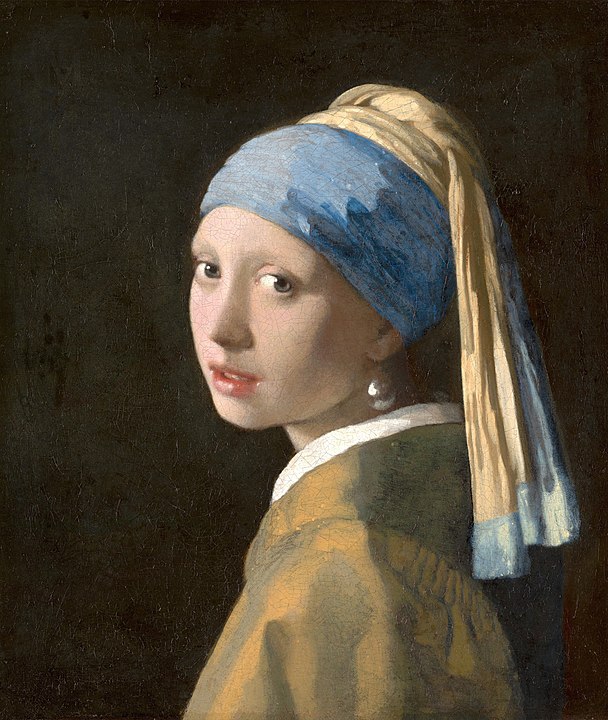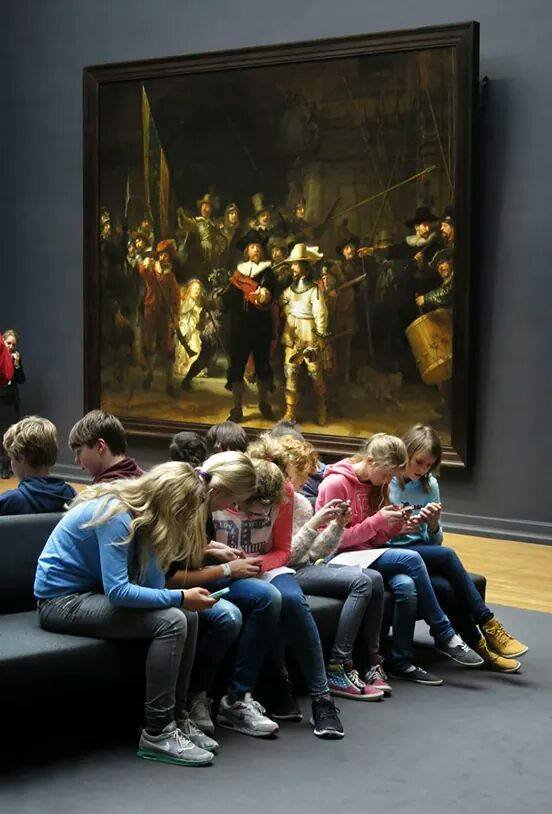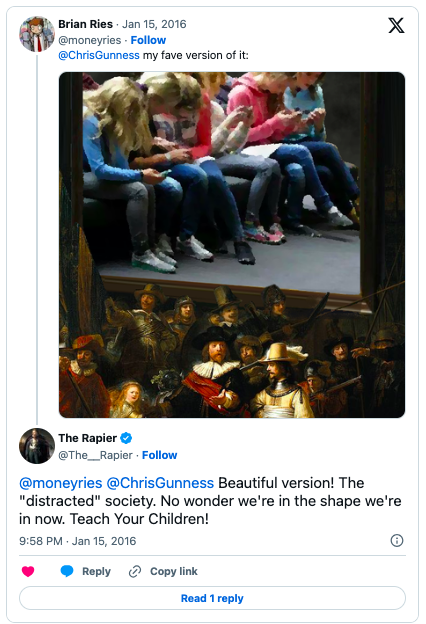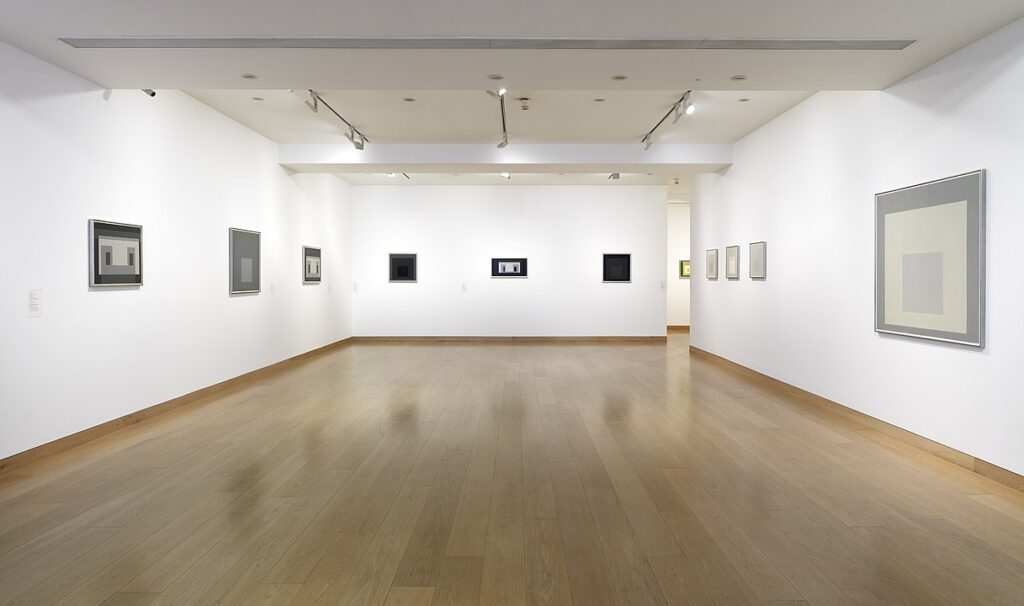Two examples of art and technology, ten years apart, might provide a useful lens through which to look at edtech and how to make it effective.
The first example, and most recent, is from a couple of weeks ago. Google and Samsung’s recent announcement made it fairly clear that there is some jaw-dropping technology around the corner. Julian Chokkattu at Wired was able to have a play:
“I’m wearing a pair of thick-rimmed glasses on my face. They don’t feel heavy, but they feel chunky. I walk over to a poster of a painting—Girl With a Pearl Earring—and ask out loud what was so special about it. A brief answer detailing its expert use of light and colour by Johannes Vermeer floats into my ears, and when I ask a follow-up about when it was painted, I quickly hear the same voice say, “around 1665.”

The second example is another Dutch masterpiece, The Night Watch. Or rather, it’s about Rembrandt’s painting and the Rijksmuseum photo that went viral nearly a decade ago.

Comments at the time tended to frame the photo in two main ways – either as a damnation of our distracted youth or as an acclamation of the age of access to knowledge. For many, it seems to have captured everything wrong with our digital age – young people, backs curved over phones, missing the majesty of Rembrandt’s masterpiece before them. (Thanks to Scary Mommy for sourcing the below)

For others, it showed something else entirely: students actively engaging with art through modern tools, the museum’s own app helping them understand what they’re seeing. As Jose Picardo noted at the time, “As part of their visit to the museum, the children, who minutes earlier had admired the art and listened attentively to explanations by expert adults, had been instructed to complete an assignment by their school teachers, using, among other things, the museum’s excellent smartphone app.”
I found thinking about these two examples of Dutch Masters, technology and us suggests a number of (not necessarily very original) ideas,
Technology changes quicker than we do.
Technology changes quicker than we do. The first, and perhaps most obvious, is the gap between the pace of technological and social change. On one level it seems stark: technology has gone from apps on phones to AI enabled glasses in 10 years while over the same period our debates about how best to use technology in education seem not to have budged. David Ardley highlights just how profound this shift might be: with estimates suggesting half the planet will need glasses by 2050, the very notion of “device control” may soon become obsolete. How do you ban smart features in corrective eyewear that students medically need?
It is not hard to imagine, in a few years’ time, an image of teens looking through lenses rather than at screens, with Gemini whispering facts about 1642 or Rembrandt, about how Rembrandt broke convention to portray the Captain and his guard as men of action or how the painting has survived fire, multiple relocations, and even a knife attack in 1975. Or, for the more cynical, suspicions of students all wearing that same glazed look, while AI whispers how to sneak out of the Rijksmuseum without your teacher noticing.
Education may be more effective than bans, but it will always be messier and slower. There’s great work being done by organisations such as the Centre for Humane Technology to help at the policy and design level. And as ever, for schools and families, Common Sense Media is doing wonders. As David, suggests, the task is “collectively eaducate (at school and home) on appropriate and responsible use through robust #digitalcitizenship education to address the issues of wellbeing and E-safety, whilst embracing the enormous opportunities … these digital technologies provide in support of education”
There’s a false binary in there somewhere, though. I’m still not sure how well any of this sits with me. To be clear, I don’t disagree with safe use of devices, I don’t disagree with digital citizenship education and I don’t disagree that there are enormous opportunities. My difficulty, at heart, is that I sense the device debate, and the distraction vs access divide steers us away from deeper issues.
“Distracted young people versus access to knowledge” is perhaps not a helpful frame. It is easy, when talking about devices, to steer into highly emotive territory. In part this is because of suggested links between devices, distraction and youth mental health. Jonathan Haidt perhaps gets the bulk of the bandwith on this with his book The Anxious Generation but it is not in any way clear that the research backs it up. Candice Odgers in Nature reports that “Hundreds of researchers, myself included, have searched for the kind of large effects suggested by Haidt. Our efforts have produced a mix of no, small and mixed associations. Most data are correlative.” It is at least, as Ben Goldacre might say, “a little bit more complicated than that.” Similarly, as the reactions to the Rijskmuseum photo illustrated, feelings run high around the state of today’s youth. That said, though, at an anecdotal, school level, you do not have to work too long with young people to sense their approach to technology is often markedly more mature than adults might assume. Nick Dennis recently fed back on his sixth formers’ nuanced and sophisticated approach to AI. A while back, some Year 8s of mine showed some grounded views of its applicability. Strip the discussion of the emotional aspects, though, and the frame is: do we want to prioritise focus or do we want to prioritise access to information. Whatever ones views of the youth of today, teaching is more than focus or access. It is the careful curation of both.
Removing distractions is not enough to foster learning; removing too many hampers it. The world of museum education would seem to support this. The white cube aesthetic “was introduced in the early twentieth century in response to the increasing abstraction of modern art. With an emphasis on colour and light, artists from groups like De Stijl and the Bauhaus preferred to exhibit their works against white walls in order to minimise distraction.“ (My emphasis).

Pablo Helguera, in his beautiful essay Label Intolerance, talks about how this focus on removing distraction can run counter to education.
For those of us who have worked professionally in the field of museum education, there is a particular aspect of that white cube nostalgia that has proved especially difficult to shed (and that remains a pet peeve for many of us): the curatorial push to banish interpretive texts from exhibitions.
I first encountered this practice while working at the Guggenheim where one of its senior curators decided not to have any extended labels whatsoever in an exhibition …. In the view of the curator, didactic texts and labels were unseemly and obstructed the visual experience. We were puzzled and frustrated, as we knew (and later confirmed) that museum visitors would be lost without this support, but the decision stood— placing additional stress on us, the educators, to find other ways to make up for this absence.
Similarly, neither does granting access to information on its own foster learning; and adding too much may hamper it. Let’s move away from the sophistication of the white cube do a very short Christmas game of Trivial Pursuits with family friends. The friends were keen to play but my father hated the game and so the day before they were due he offered my sister (11) and me (12) £20 to learn as much as we could of each box. They arrived and it was an embarrassingly short game. I had done my homework and started answering most of the questions. The mother was rightly suspicious that I knew so much about Tennessee Williams, 1970s Darts championships and latitudes of global cities. Luckily, when she challenged me, “Who was Rommel again?”, it was on one of the few topics I knew anything about. I’m not very proud of it, but the point is that for that afternoon I had plentiful access to information and close zero understanding of what any of it meant. If the Dutch Masters, our rapid tech advances and our being mired in the same debate tell us anything, then perhaps it is that content delivery is not enough. It’s the easiest way to “do education” with technology, but it’s not enough. At a very basic level, it misses out the context, physical, emotional and intellectual; at a more human level, it misses out why any of what is being learned, be it Tennessee Williams or the Night Watch might matter. For that, some sort of curation is needed.
A more helpful frame for how to use technology might be that of the storyteller. At my current school, perhaps the most famous storyteller-teacher is Craig Gordon. If you chat to the pupils about it, they’ll talk about how he brings it all to life, how he makes you feel as though you’re all exploring it together and how asking a question becomes exciting. And if you see him in action on a school trip, it’s hard not to want to lean in and hear more yourself. In our latest TeachMeet, Craig was asked to give a little insight into his tips and tricks. Perhaps most striking was how little technology was needed. Perhaps a printout of a “long lost Magna Carta” rolled up in an old poster tube “for safe-keeping”, a few selected images to project – but nothing more – everything served the story. He leaves questions hanging, invites pupils to do historical detective work with him and encourages them to come up with their own interpretations. Then, once the scene has been set, the pupils are let loose on the research, be it from worksheets, books or the web.
In a funny way, this approach is both curiously old-fashioned and curiously modern. It certainly sidesteps the quagmire of the access (facts, Mr Gradgrind) versus focus (weapons of mass distraction) debate. The emphasis is not “How do we control technology?” or “How do we maximise access?”, it is more simply “How do we create meaning?”. The power of the storytelling approach, then, lies not in the value of subject matter, nor in the complexity of the tools, but in the strength of the connection.
Consider again those students at the Rijksmuseum. The missing piece wasn’t better apps or stricter phone policies – it was the curator-teacher Jose Picardo mentioned, who had “minutes earlier” given them context and purpose. This is where real engagement happens: when technology amplifies rather than replaces human connection.
All of which suggests a formula that isn’t complex:
- Start with story and human connection – just as the Rijksmuseum expert did before the phones came out
- Create curiosity and context – like Helguera’s museum educators finding ways around the missing labels, or Craig Gordon with his “discovered” Magna Carta
- Then unleash the power of technological tools – whether museum apps, AI glasses, or even an old-fashioned textbook – whatever comes next to help pupils explore for themselves.
And so we come full circle to those AI glasses and Vermeer. In terms of teaching, the technology isn’t the problem or the solution but a tool waiting for a storyteller. When Craig Gordon rolls out his “ancient” Magna Carta, or when the Rijksmuseum expert is describing the background to The Night Watch, they’re not just sharing information – they’re creating a framework where every subsequent fact, whether from book, device, or AI whisper, has somewhere meaningful to land.
[Header image – Source: Wikipedia/Library of Congress – Illustration of camera obscura from “Sketchbook on military art, including geometry, fortifications, artillery, mechanics, and pyrotechnics”]
